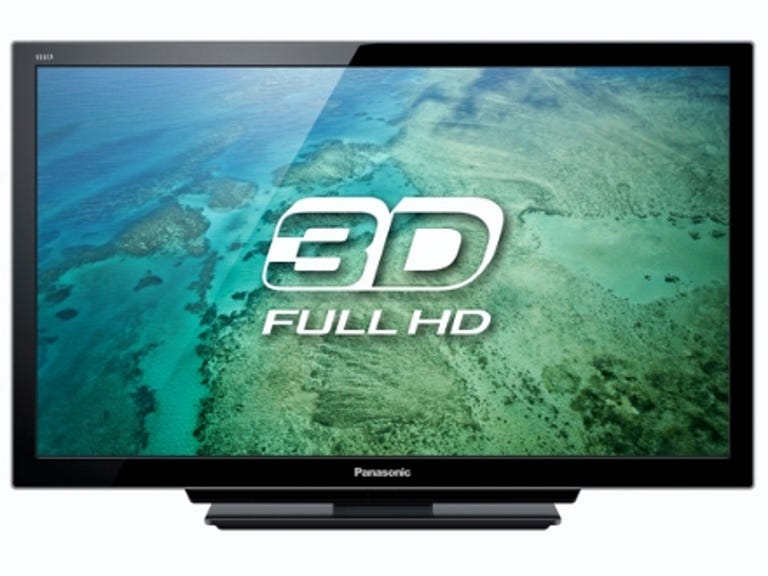 Why You Can Trust CNET
Why You Can Trust CNET Panasonic Viera DT30 (TX-L32DT30B) review: Panasonic Viera DT30 (TX-L32DT30B)
The 32-inch Panasonic Viera TX-L32DT30B LED TV is a revelation. It shows that LCD technology really can compete with plasma when it comes to producing clean and engaging 3D images. Unfortunately, it's very expensive.
Until recently, Panasonic had shied away from making 3D LCD TVs. The company claimed LCD panels suffered too much from image cross-talk, whereby ghosting appears around the edges of objects in 3D scenes. Instead, Panasonic focused its 3D endeavours on its well-received plasma screens.
The Good
The Bad
The Bottom Line
Now Panasonic reckons it's cracked the cross-talk issue on LCD TVs, and the 32-inch, 1080p, LED-illuminated Viera TX-L32DT30B is the first fruit of these labours. We were impressed by the larger Viera TX-L37DT30B when we saw it earlier in the year, but can its smaller sibling justify its £880 price tag?
3D delights
The key to the TX-L32DT30B's enhanced 3D performance is a redesigned IPS Alpha panel that has a much faster response time than previous models. This has been achieved by pushing the LED backlight closer to the actual panel, and also by using a new type of liquid crystal in the panel itself.
Panasonic reckons these measures have increased the response time by around 50 per cent. On top of this, the set also offers 400Hz motion-processing technology. This is achieved by using a 200Hz refresh rate and then adding a scanning backlight.
As a result, the TV's 3D pictures are light years ahead of what we've seen from other LCD tellies so far. Panasonic has pretty much nailed it. The fast response time really has almost totally eliminated cross-talk and now puts LCD technology pretty much on a par with plasma when it comes to image quality.
In fact, LCD might actually be more desirable, due to the extra brightness afforded by the LED backlight. This really helps to negate the dimming effect of the active 3D glasses, as images retain much more brightness and punch than on most plasma TVs, which further enhances the impressive sense of depth when watching 3D material.
Unfortunately, the set doesn't come with any glasses, and they'll set you back around £100 each. Consequently, large families may find LG's passive 3D TVs to be a better deal, with compatible glasses costing around £2 each.
Divine 2D
The TV is an accomplished performer when it comes to 2D as well. The LED backlight helps pictures to look really bright and punchy, while colours look very warm and natural too.
Motion is also impressively smooth, helped along by the panel's fast response rate and Panasonic's Intelligent Frame Creation software. It's best to keep the latter set to about medium, though, as otherwise pictures can look rather flat and video-like, which isn't ideal for film material, such as movies on Blu-ray.

The only real problem is one that affects most LED sets with local-dimming capability. When dimming is enabled and you have bright areas of the picture overlaid on very dark areas -- for example, white subtitles on a black background -- you can see haloing around the brighter areas of the picture. That said, this isn't something that affects most footage and, under normal conditions, the local dimming really helps the set to produce very deep and rich black levels.
Handsome fellow
Panasonic has finally started to pay more attention to the design of its sets, with the result that the TX-L32DT30B is a much more stylish affair than last year's models. The glossy finish and metallic strip around the outside of the frame help to add a touch of class too.
The TV is slim, with its panel measuring just 33mm thick. It's thicker at the bottom, though, to accommodate a decent set of speakers, rather than the puny ones you usually find in LED TVs. This is a smart move because the TX-L32DT30B delivers relatively impressive audio, with stronger bass than most flat-panel TVs can muster.
Panasonic has also improved its Internet TV service, which is now called Viera Connect. Once you've hooked the set up to your router via its Ethernet port, or installed the optional Wi-Fi dongle, you'll find that it includes a good implementation of BBC's iPlayer service, along with other options such as the Acetrax movie-rental service, YouTube and Dailymotion. There's also support for a range of social-networking and picture-sharing services, including Skype, Facebook, Twitter and Picasa. All in all, it's an impressive line-up.
The set can stream a range of file formats, including Xvid and MKV files, across a network from a PC or network-attached storage drive. It can also play back these files from USB-attached storage, such as hard drives and memory keys. What's more, if you connect a USB hard drive, you can take advantage of a basic TV-recording feature, so you can record shows to disc from the Freeview HD tuner, or simply pause and rewind live TV.
Conclusion
The Panasonic Viera TX-L32DT30B is a revelation. It shows that LCD technology really can compete with plasma when it comes to producing clean and engaging 3D images. It's also a sterling performer with 2D content. We just wish the set weren't so expensive, and that the DT30 range included models larger than 37 inches, so you could make the most of the excellent 3D performance.
Edited by Charles Kloet


